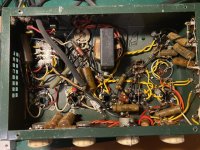Looking to restore an old mono tube amp of unknown condition. Opened it up, and saw the output transformer secondary side looking "loose" (upper center of attached picture). As in, the sheets aren't wrapped tight like on the primary side. Is this normal?
Attachments
I've seen transformers in old radios in worse visual condition that worked fine, but I'm certainly not an expert. I reckon the best thing to do is to take it out and test it on its own, either through a variac or at least a light-bulb tester, if you don't want to blow up a fuse.
The 'loose' side is where the secondary connections are made up. It is normal and ''looks'' fine.
Only way to tell if it is good is to measure the winding resistances. Primary will be low hundreds of ohms, secondary will be very low ohms. Then make sure the primary to metal core/chassis is open circuit.
Only way to tell if it is good is to measure the winding resistances. Primary will be low hundreds of ohms, secondary will be very low ohms. Then make sure the primary to metal core/chassis is open circuit.
Going by the components it looks like early 50,s .
Yes I too have seen worse in old tube radio repair that still worked .
In those days high quality transformers cost a lot more and were usually fitted in government/forces equipment --communication receivers and the like but that transformer is "standard issue " for most old radios I repaired.
If you go right back to the 20,s some transformers were tied with string.
Yes I too have seen worse in old tube radio repair that still worked .
In those days high quality transformers cost a lot more and were usually fitted in government/forces equipment --communication receivers and the like but that transformer is "standard issue " for most old radios I repaired.
If you go right back to the 20,s some transformers were tied with string.
